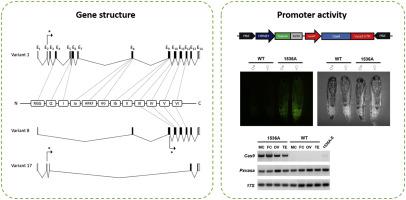当前位置:
X-MOL 学术
›
Insect Biochem. Mol. Biol.
›
论文详情
Our official English website, www.x-mol.net, welcomes your
feedback! (Note: you will need to create a separate account there.)
Identification and characterization of the vasa gene in the diamondback moth, Plutella xylostella.
Insect Biochemistry and Molecular Biology ( IF 3.2 ) Pub Date : 2020-04-10 , DOI: 10.1016/j.ibmb.2020.103371 Xuejiao Xu , Jie Yang , Tim Harvey-Samuel , Yuping Huang , Muhammad Asad , Wei Chen , Weiyi He , Guang Yang , Luke Alphey , Minsheng You
Insect Biochemistry and Molecular Biology ( IF 3.2 ) Pub Date : 2020-04-10 , DOI: 10.1016/j.ibmb.2020.103371 Xuejiao Xu , Jie Yang , Tim Harvey-Samuel , Yuping Huang , Muhammad Asad , Wei Chen , Weiyi He , Guang Yang , Luke Alphey , Minsheng You

|
Vasa is an ATP-dependent RNA helicase, participating in multiple biological processes. It has been widely used as a germ cell marker and its promoter has become a key component of several genetic pest control systems. Here we present the vasa gene structure and its promoter activity in Plutella xylostella, one of the most destructive pests of cruciferous crops. Full length Pxvasa cDNA sequences were obtained, revealing 14 exons and at least 30 alternatively spliced transcripts. Inferred amino acid sequences showed nine conserved DEAD-box family protein motifs with partial exclusion from some isoforms. Real-time quantitative PCR indicated the up-regulation of Pxvasa in both female and male adults compared with other developmental stages, and the expression levels of Pxvasa were found to be much higher in adult gonads, especially ovaries, than in other tissues. The putative promoter region of Pxvasa was sequenced and several ecdysone-induced transcription factor (TF) binding sites were predicted in silico. To further analyze the promoter region, two upstream regulatory fragments of different lengths were tested as putative promoters in transient cell and embryo expression assays, one of which was subsequently utilized to drive Cas9 expression in vivo. A transgenic line was recovered and the expression patterns of Cas9 and native Pxvasa were profiled in adult tissues and eggs with RT-PCR. This work provides the foundation for further studies on the gene functions of Pxvasa as well as the potential application of its promoter in genetic manipulation of P. xylostella.
中文翻译:

小菜蛾小菜蛾瓦萨基因的鉴定和鉴定。
Vasa是一种ATP依赖性RNA解旋酶,参与多种生物学过程。它已被广泛用作生殖细胞标记,其启动子已成为几种遗传害虫防治系统的关键组成部分。在这里,我们介绍了小菜蛾(Plutella xylostella)中的瓦萨基因结构及其启动子活性,小菜蛾是十字花科作物中最具破坏性的害虫之一。获得了全长Pxvasa cDNA序列,揭示了14个外显子和至少30个选择性剪接的转录本。推导的氨基酸序列显示了9个保守的DEAD-box家族蛋白基序,部分被某些亚型排除。实时定量PCR表明,与其他发育阶段相比,成年雌性和成年雌性Pxvasa均上调,并且发现成年性腺,尤其是卵巢中Pxvasa的表达水平更高,比其他组织。对推定的Pxvasa启动子区域进行测序,并在计算机上预测了几个蜕皮激素诱导的转录因子(TF)结合位点。为了进一步分析启动子区域,在瞬时细胞和胚胎表达测定中测试了两个不同长度的上游调控片段作为推定的启动子,随后其中之一用于体内驱动Cas9表达。回收了转基因品系,并通过RT-PCR分析了Cas9和天然Pxvasa在成人组织和卵中的表达模式。这项工作为进一步研究Pxvasa的基因功能以及其启动子在小菜蛾的基因操纵中的潜在应用提供了基础。对推定的Pxvasa启动子区域进行测序,并在计算机上预测了几个蜕皮激素诱导的转录因子(TF)结合位点。为了进一步分析启动子区域,在瞬时细胞和胚胎表达测定中测试了两个不同长度的上游调控片段作为推定的启动子,随后其中之一用于体内驱动Cas9表达。回收了转基因品系,并通过RT-PCR分析了Cas9和天然Pxvasa在成人组织和卵中的表达模式。这项工作为进一步研究Pxvasa的基因功能以及其启动子在对小菜蛾的基因操作中的潜在应用提供了基础。对推定的Pxvasa启动子区域进行测序,并在计算机上预测了几个蜕皮激素诱导的转录因子(TF)结合位点。为了进一步分析启动子区域,在瞬时细胞和胚胎表达测定中测试了两个不同长度的上游调控片段作为推定的启动子,随后其中之一用于体内驱动Cas9表达。回收了转基因品系,并通过RT-PCR分析了Cas9和天然Pxvasa在成人组织和卵中的表达模式。这项工作为进一步研究Pxvasa的基因功能以及其启动子在小菜蛾的基因操纵中的潜在应用提供了基础。在瞬时细胞和胚胎表达测定中,将两个不同长度的上游调控片段作为推定的启动子进行了测试,其中之一随后被用于体内驱动Cas9表达。回收转基因品系,并通过RT-PCR分析Cas9和天然Pxvasa在成人组织和卵中的表达模式。这项工作为进一步研究Pxvasa的基因功能以及其启动子在小菜蛾的基因操纵中的潜在应用提供了基础。在瞬时细胞和胚胎表达测定中,将两个不同长度的上游调控片段作为推定的启动子进行了测试,其中之一随后被用于体内驱动Cas9表达。回收了转基因品系,并通过RT-PCR分析了Cas9和天然Pxvasa在成人组织和卵中的表达模式。这项工作为进一步研究Pxvasa的基因功能以及其启动子在对小菜蛾的基因操作中的潜在应用提供了基础。
更新日期:2020-04-10
中文翻译:

小菜蛾小菜蛾瓦萨基因的鉴定和鉴定。
Vasa是一种ATP依赖性RNA解旋酶,参与多种生物学过程。它已被广泛用作生殖细胞标记,其启动子已成为几种遗传害虫防治系统的关键组成部分。在这里,我们介绍了小菜蛾(Plutella xylostella)中的瓦萨基因结构及其启动子活性,小菜蛾是十字花科作物中最具破坏性的害虫之一。获得了全长Pxvasa cDNA序列,揭示了14个外显子和至少30个选择性剪接的转录本。推导的氨基酸序列显示了9个保守的DEAD-box家族蛋白基序,部分被某些亚型排除。实时定量PCR表明,与其他发育阶段相比,成年雌性和成年雌性Pxvasa均上调,并且发现成年性腺,尤其是卵巢中Pxvasa的表达水平更高,比其他组织。对推定的Pxvasa启动子区域进行测序,并在计算机上预测了几个蜕皮激素诱导的转录因子(TF)结合位点。为了进一步分析启动子区域,在瞬时细胞和胚胎表达测定中测试了两个不同长度的上游调控片段作为推定的启动子,随后其中之一用于体内驱动Cas9表达。回收了转基因品系,并通过RT-PCR分析了Cas9和天然Pxvasa在成人组织和卵中的表达模式。这项工作为进一步研究Pxvasa的基因功能以及其启动子在小菜蛾的基因操纵中的潜在应用提供了基础。对推定的Pxvasa启动子区域进行测序,并在计算机上预测了几个蜕皮激素诱导的转录因子(TF)结合位点。为了进一步分析启动子区域,在瞬时细胞和胚胎表达测定中测试了两个不同长度的上游调控片段作为推定的启动子,随后其中之一用于体内驱动Cas9表达。回收了转基因品系,并通过RT-PCR分析了Cas9和天然Pxvasa在成人组织和卵中的表达模式。这项工作为进一步研究Pxvasa的基因功能以及其启动子在对小菜蛾的基因操作中的潜在应用提供了基础。对推定的Pxvasa启动子区域进行测序,并在计算机上预测了几个蜕皮激素诱导的转录因子(TF)结合位点。为了进一步分析启动子区域,在瞬时细胞和胚胎表达测定中测试了两个不同长度的上游调控片段作为推定的启动子,随后其中之一用于体内驱动Cas9表达。回收了转基因品系,并通过RT-PCR分析了Cas9和天然Pxvasa在成人组织和卵中的表达模式。这项工作为进一步研究Pxvasa的基因功能以及其启动子在小菜蛾的基因操纵中的潜在应用提供了基础。在瞬时细胞和胚胎表达测定中,将两个不同长度的上游调控片段作为推定的启动子进行了测试,其中之一随后被用于体内驱动Cas9表达。回收转基因品系,并通过RT-PCR分析Cas9和天然Pxvasa在成人组织和卵中的表达模式。这项工作为进一步研究Pxvasa的基因功能以及其启动子在小菜蛾的基因操纵中的潜在应用提供了基础。在瞬时细胞和胚胎表达测定中,将两个不同长度的上游调控片段作为推定的启动子进行了测试,其中之一随后被用于体内驱动Cas9表达。回收了转基因品系,并通过RT-PCR分析了Cas9和天然Pxvasa在成人组织和卵中的表达模式。这项工作为进一步研究Pxvasa的基因功能以及其启动子在对小菜蛾的基因操作中的潜在应用提供了基础。











































 京公网安备 11010802027423号
京公网安备 11010802027423号